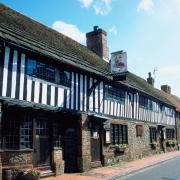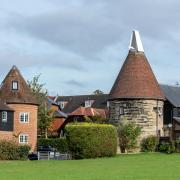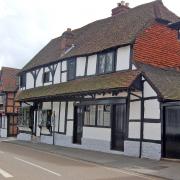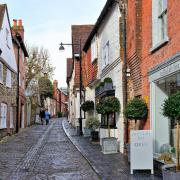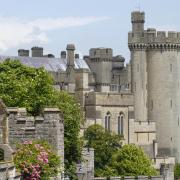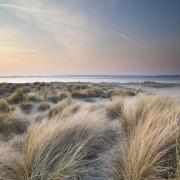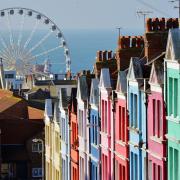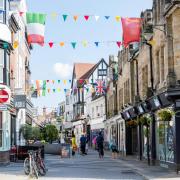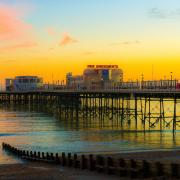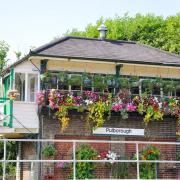Contraband goods provided a valuable source of income for Rottingdean in years past, and a number of illustrious figures have made it their home since then as Clive Agran discovers

The delightful village squeezed between the Downs and the English Channel that I encounter after rolling down a long hill comes as something of a surprise. There’s not even the merest whiff of decay as implied by its name. Instead there’s evident prosperity, attractive houses, a pretty pond, neat streets, flint walls, an appealing green, a bracing sea breeze and an exceptionally pleasant environment. Perhaps the only negative is finding somewhere to park in what is clearly a popular spot located just a few miles east of Brighton.
My luck is in – I find a suitable parking place and my guide is a demonstrably cheery fellow who’s not bothered that I’m a little late. Honorary archivist at the influential and energetic Rottingdean Preservation Society (RPS), Michael Laslett loves the place and clearly knows his stuff.
We sit down in the front room of the Grange, a handsome Georgian building that was remodelled by Lutyens and which is one of several historic attractions in the village that RPS helps look after. Here it leases the upper part of the building, which houses a gallery and museum.
Originally the vicarage, from 1792-1838 the Grange was home to one of Rottingdean’s most beloved inhabitants, the Reverend Dr Thomas Redman Hooker. As well as being vicar of nearby St Margaret’s church, he was master of the Brookside Harriers (one of the most famous packs of hounds in the country), a schoolmaster, a competent cellist and a key player in the local smuggling operation. Curiously, this remarkably colourful character taught nephews of both Napoleon and Wellington.
Although obviously illegal, smuggling helped Hooker’s poor parishioners to survive and Michael, with frequent and necessary warnings to “mind your head”, escorts me into the basement to see one of the tunnels that linked to nearby properties. Another one of RPS’s responsibilities, the windmill above the village, also played a key role in this nefarious activity by signalling with its sails whether the coast was clear.
A nationally better known resident of the Grange was Sir William Nicholson, who produced a number of downland and coastal oil paintings in the early part of the last century. He was not, however, Rottingdean’s most renowned artist; that distinction belongs to Sir Edward Burne-Jones. An enormously successful painter of the Pre-Raphaelite movement, a pupil of Rossetti’s and close friend of William Morris, Burne-Jones was also involved in the rejuvenation of stained glass art in Britain, more of which later.
In 1860, he married Georgiana MacDonald. Also an artist, she was one of the ‘Amazing’ MacDonald sisters, another one of whom married Alfred Baldwin and gave birth to Stanley, who later became prime minister. In 1880 the Burne-Jones family bought Prospect House, an imposing property on the opposite side of the green to the Grange. They used it as a holiday home and soon after acquired the house next door to create North End House. Now with plenty of spare rooms, they invited many important guests to stay including another famous son of yet another of the ‘Amazing’ MacDonald sisters, Rudyard Kipling, who subsequently rented the big house over the road, the Elms. Kipling lived there for five years before moving to Bateman’s in Burwash partly because it was further from the road and a safer distance from his adoring fans.
Unlike Bateman’s, which is a National Trust property, the Elms is privately owned but what was the garden has been saved from development by the efforts of many, including the RPS. Kipling Gardens is a truly beautiful little park in the centre of the village.
Michael points out what he describes as a ‘wishing stone’ in the wall around the Elms where, if you rub the nose of the gargoyle-like feature and spin around three times, you’re entitled to a wish. I’m somewhat sceptical – only Spurs winning next year’s European Champions’ league will convince me of the stone’s efficacy.

Before we enter beautiful St Margaret’s Church and wander around the graveyard, I should mention that the Burne-Jones holiday home was subsequently occupied by another of Rottingdean’s illustrious former residents, Enid Bagnold. The author of National Velvet was apparently inspired to write her hugely successful play The Chalk Garden by the garden at North End House. After its premiere on Broadway in 1955, the play opened in London The movie starring Edith Evans, Deborah Kerr, Hayley Mills and John Mills was shot locally in 1964. A new production featuring Penelope Keith and Amanda Root formed part of this year’s programme at Chichester Festival Theatre.
Originating in Saxon times, St Margaret’s is a beautiful church that sits comfortably next to the green. Seven of its splendid stained glass windows were designed by Sir Edward Burne-Jones, who presented them to celebrate the marriage in the church of his beloved daughter, coincidentally named Margaret. Stanley Baldwin also married here and a chair the Baldwins donated stands in the chancel.
Above the pulpit is a head-and-shoulders sculpture of one of Rottingdean’s most popular former vicars, Dr Hooker. The present incumbent, Father Anthony Moore, quips that he might be the only vicar to preach beneath the bust of a hooker.
Michael recounts a gruesome tale from 1377 when dozens of villagers perished after seeking refuge in the tower from French invaders who cruelly set it alight. Evidence of this atrocity can be seen in the red scorch marks on the pillars supporting a three-bay south aisle that was added by Sir George Gilbert Scott in 1856 using stone salvaged from the damaged tower.
Graveyards are poignant places and just reading the names on the headstones and the brief epitaphs is moving. Here the emotion is heightened as Michael is carrying a folder with a few photos and more detailed biographies with which, if you will pardon the expression, he uses to put flesh on the bones.
Just outside the entrance occupying a sunny spot in a sheltered corner is a well–maintained flower bed onto which were scattered the ashes of Sir Edward Byrne-Jones and his wife Georgiana.
Their granddaughter and accomplished author, Angela Thirkell, is nearby beneath a wooden ‘headstone’ called a leaping board. It’s rotting, which accords with her wishes of wanting it to eventually disappear. Had she had a stone, it might well have been inscribed with perhaps her most famous quote. When interviewed by The Observerand reflecting on a failed marriage, she memorably remarked: “It’s very peaceful with no husbands.”
Another headstone is decorated with a skull and crossbones. Many mistakenly believe a pirate lies beneath it. “In the 1750s it was just a style of the time,” explains Michael.
Enid Bagnold is buried here as is her remarkable brother, Brigadier Ralph Alger Bagnold. A pioneer in desert exploration, he founded the British Army’s Long-Range Desert Group, which was the precursor of the SAS. An accomplished academic after World War II, he even has a desert feature on Mars named after him (the Bagnold Dunes).
Literally back down on earth there is ‘Coppers Corner’ where members of the famous folk-singing family are buried. Others from the world of showbiz include GH Elliott, a music hall artist of the 1930s and 1940s who was one of Britain’s best-loved ‘blackface’ performers in the 1930s and 40s, famous for singing Lily of Lagunaand By the Light of the Silvery Moon.
His stage name, which appears on his gravestone, would be considered deeply racist today. The most visited grave, according to Michael, is that of Gary Moore, the famous rock guitarist who played with Thin Lizzy and tragically died of a heart attack while holidaying in Spain in 2011.
Reluctant to end on a sad note, I would urge visitors to look out at low tide for the remains of concrete sleepers a short distance from the shore.
They are all that’s left of the Brighton and Rottingdean Seashore Electric Railway. Nicknamed ‘Daddy Long-Legs’ and designed by Magnus Volk, it was part train, part boat and rolled through the shallow waters for a few years at the end of the 19th century. Apart from anything else, it was the only train that carried lifeboats.
More…
• The history of Brighton - Clive Agran gets a new perspective on the much loved seaside city of Brighton
• The history of Horsham - One of the prettiest streets in West Sussex, a Romantic poet and a surprising number of executions make an historical tour of Horsham a memorable experience for Clive Agran








